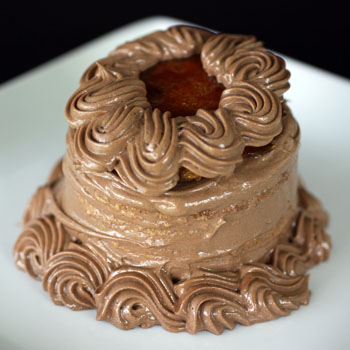
The August 2009 Daring Bakers’ challenge was hosted by Angela of A Spoonful
of Sugar and Lorraine of Not Quite Nigella. They chose the spectacular Dobos
Torte based on a recipe from Rick Rodgers’ cookbook Kaffeehaus: Exquisite
Desserts from the Classic Caffés of Vienna, Budapest, and Prague.
This month’s Daring Bakers post will prove to you (as if you needed proof) that not everything in my kitchen turns out well! I was really excited to make the Dobos Torta… I love multi-layer cakes, especially when I can bake the layers individually and don’t have to attempt to cut and level them myself (that never ends well). Unfortunately, something went very wrong when I was baking this month!
I decided to make mini individual tortas, using a large round cookie cutter to cut out circles from each baked layer of the cake. It took me a few tries to bake the cake the appropriate length of time so that I could cut out the circles without tearing/breaking the sponge cake layer into lots of little pieces. It seems that I also must have burnt the caramel… I took it off of the heat as soon as it darkened, but the taste was really bad, so I must have burnt it. The only other thing that I think may have happened was that I may have added too much lemon. The strong lemon taste was unmistakable in the caramel.
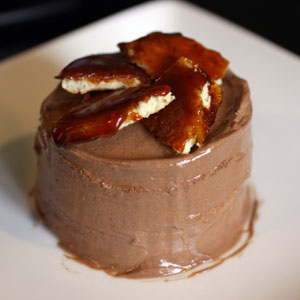
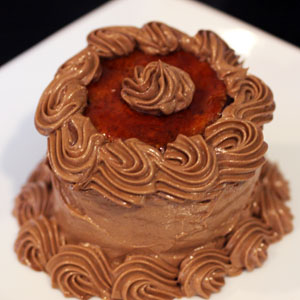
So, while my pictures may make my attempt look like a success, I wasn’t too pleased with my results. My husband and I each had a few bites, but most of my hard work landed in the garbage. I meant to re-do the recipe, but ran out of time. Be sure to check back at The Daring Kitchen to see all of the other bakers who actually completed this month’s challenge successfully!
Here’s the original recipe and directions from our wonderful hosts (with a few of my pictures thrown in along the way)…
The Dobos Torta is a five-layer sponge cake, filled with a rich chocolate buttercream and topped with thin wedges of caramel. (You may come across recipes which have anywhere between six and 12 layers of cake; there are numerous family variations!) It was invented in 1885 by József C. Dobos, a Hungarian baker, and it rapidly became famous throughout Europe for both its extraordinary taste and its keeping properties. The recipe was a secret until Dobos retired in 1906 and gave the recipe to the Budapest Confectioners’ and Gingerbread Makers’ Chamber of Industry, providing that every member of the chamber can use it freely.
Equipment
- 2 baking sheets
- 9” (23cm) springform tin and 8” cake tin, for templates
- Mixing bowls (1 medium, 1 large)
- Sieve
- Double boiler (a large saucepan plus a large heat-proof mixing bowl which fits snugly over the top of the pan)
- Small saucepan
- Whisk (you could use a balloon whisk for the entire cake, but an electric hand whisk or stand mixer will make life much easier)
- Metal offset spatula
- Sharp knife
- 7 1/2” cardboard cake round, or just build cake on the base of a sprinfrom tin
- Piping bag and tip, optional
Prep Times
- Sponge layers 20 mins prep, 40 mins cooking total if baking each layer individually.
- Buttercream: 20 mins cooking. Cooling time for buttercream: about 1 hour plus 10 minutes after this to beat and divide.
- Caramel layer: 10-15 minutes.
- Assembly of whole cake: 20 minutes
Sponge Cake Layers Ingredients
- 6 large eggs, separated, at room temperature
- 1 1/3 cups (162g) confectioner’s (icing) sugar, divided
- 1 teaspoon (5ml) vanilla extract
- 1 cup plus 2 tablespoons (112g) sifted cake flour (SUBSTITUTE 95g plain flour + 17g cornflour (cornstarch) sifted together)
- Pinch of salt
Chocolate Buttercream Ingredients
- 4 large eggs, at room temperature
- 1 cup (200g) caster (ultrafine or superfine white) sugar
- 4oz (110g) bakers chocolate or your favourite dark chocolate, finely chopped
- 2 sticks plus 2 tablespoons (250g) unsalted butter, at room temperature
Caramel Topping Ingredients
- 1 cup (200g) caster (superfine or ultrafine white) sugar
- 12 tablespoons (180 ml) water
- 8 teaspoons (40 ml) lemon juice
- 1 tablespoon neutral oil (e.g. grapeseed, rice bran, sunflower)
Finishing Touches Ingredients
- 12 whole hazelnuts, peeled and toasted
- ½ cup (50g) peeled and finely chopped hazelnuts
Directions for the sponge layers:
NB. The sponge layers can be prepared in advance and stored interleaved with parchment and well-wrapped in the fridge overnight.
- Position the racks in the top and centre thirds of the oven and heat to 400F (200C).
- Cut six pieces of parchment paper to fit the baking sheets. Using the bottom of a 9″ (23cm) springform tin as a template and a dark pencil or a pen, trace a circle on each of the papers, and turn them over (the circle should be visible from the other side, so that the graphite or ink doesn’t touch the cake batter.)
- Beat the egg yolks, 2/3 cup (81g) of the confectioner’s (icing) sugar, and the vanilla in a medium bowl with a mixer on high speed until the mixture is thick, pale yellow and forms a thick ribbon when the beaters are lifted a few inches above the batter, about 3 minutes. (You can do this step with a balloon whisk if you don’t have a mixer.)
- In another bowl, using clean beaters, beat the egg whites until soft peaks form. Gradually beat in the remaining 2/3 cup (81g) of confectioner’s (icing)sugar until the whites form stiff, shiny peaks. Using a large rubber spatula, stir about 1/4 of the beaten whites into the egg yolk mixture, then fold in the remainder, leaving a few wisps of white visible. Combine the flour and salt. Sift half the flour over the eggs, and fold in; repeat with the remaining flour.
- Line one of the baking sheets with a circle-marked paper. Using a small offset spatula, spread about 3/4cup of the batter in an even layer, filling in the traced circle on one baking sheet. Bake on the top rack for 5 minutes, until the cake springs back when pressed gently in the centre and the edges are lightly browned. While this cake bakes, repeat the process on the other baking sheet, placing it on the centre rack. When the first cake is done, move the second cake to the top rack. Invert the first cake onto a flat surface and carefully peel off the paper. Slide the cake layer back onto the paper and let stand until cool. Rinse the baking sheet under cold running water to cool, and dry it before lining with another parchment. Continue with the remaining papers and batter to make a total of six layers. Completely cool the layers. Using an 8″ springform pan bottom or plate as a template, trim each cake layer into a neat round. (A small serrated knife is best for this task.)
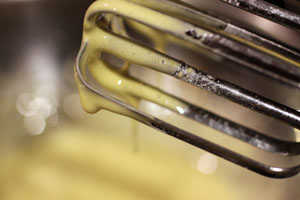
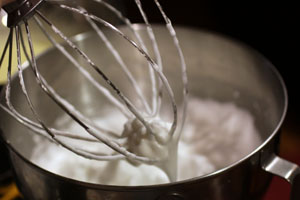
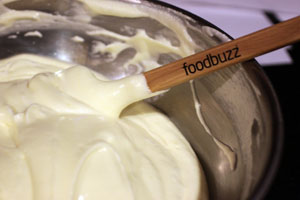
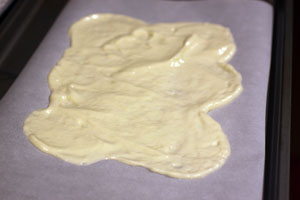
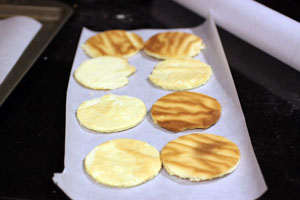
Directions for the chocolate buttercream:
NB. This can be prepared in advance and kept chilled until required.
- Prepare a double-boiler: quarter-fill a large saucepan with water and bring it to a boil.
- Meanwhile, whisk the eggs with the sugar until pale and thickened, about five minutes. You can use a balloon whisk or electric hand mixer for this.
- Fit bowl over the boiling water in the saucepan (water should not touch bowl) and lower the heat to a brisk simmer. Cook the egg mixture, whisking constantly, for 2-3 minutes until you see it starting to thicken a bit. Whisk in the finely chopped chocolate and cook, stirring, for a further 2-3 minutes.
- Scrape the chocolate mixture into a medium bowl and leave to cool to room temperature. It should be quite thick and sticky in consistency.
- When cool, beat in the soft butter, a small piece (about 2 tablespoons/30g) at a time. An electric hand mixer is great here, but it is possible to beat the butter in with a spatula if it is soft enough. You should end up with a thick, velvety chocolate buttercream. Chill while you make the caramel topping.
Lorraine’s note: If you’re in Winter just now your butter might not soften enough at room temperature, which leads to lumps forming in the buttercream. Male sure the butter is of a very soft texture I.e. running a knife through it will provide little resistance, before you try to beat it into the chocolate mixture. Also, if you beat the butter in while the chocolate mixture is hot you’ll end up with more of a ganache than a buttercream!
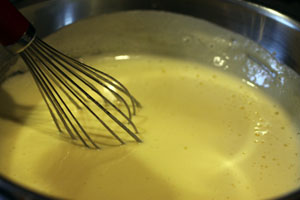
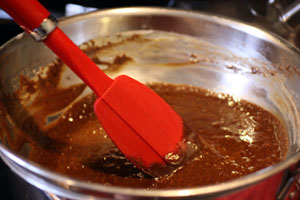
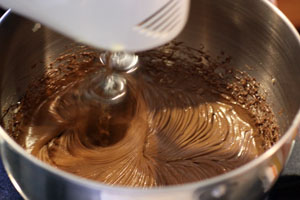
Directions for the caramel topping:
- Choose the best-looking cake layer for the caramel top. To make the caramel topping: Line a jellyroll pan with parchment paper and butter the paper. Place the reserved cake layer on the paper. Score the cake into 12 equal wedges. Lightly oil a thin, sharp knife and an offset metal spatula.
- Stir the sugar, water and lemon juice in a small saucepan. Bring to a boil over a medium heat, stirring often to dissolve the sugar. Once dissolved into a smooth syrup, turn the heat up to high and boil without stirring, swirling the pan by the handle occasionally and washing down any sugar crystals on the sides of the pan with a wet brush until the syrup has turned into an amber-coloured caramel.
- The top layer is perhaps the hardest part of the whole cake so make sure you have a oiled, hot offset spatula ready. I also find it helps if the cake layer hasn’t just been taken out of the refrigerator. I made mine ahead of time and the cake layer was cold and the toffee set very, very quickly—too quickly for me to spread it. Immediately pour all of the hot caramel over the cake layer. You will have some leftover most probably but more is better than less and you can always make nice toffee pattern using the extra to decorate. Using the offset spatula, quickly spread the caramel evenly to the edge of the cake layer. Let cool until beginning to set, about 30 seconds. Using the tip of the hot oiled knife (keep re-oiling this with a pastry brush between cutting), cut through the scored marks to divide the caramel layer into 12 equal wedges. Cool another minute or so, then use the edge of the knife to completely cut and separate the wedges using one firm slice movement (rather than rocking back and forth which may produce toffee strands). Cool completely.
Angela’s note: I recommend cutting, rather than scoring, the cake layer into wedges before covering in caramel (reform them into a round). If you have an 8” silicon round form, then I highly recommend placing the wedges in that for easy removal later and it also ensures that the caramel stays on the cake layer. Once set, use a very sharp knife to separate the wedges.
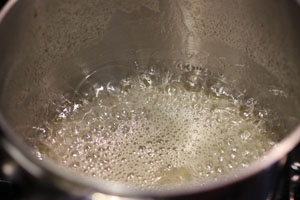
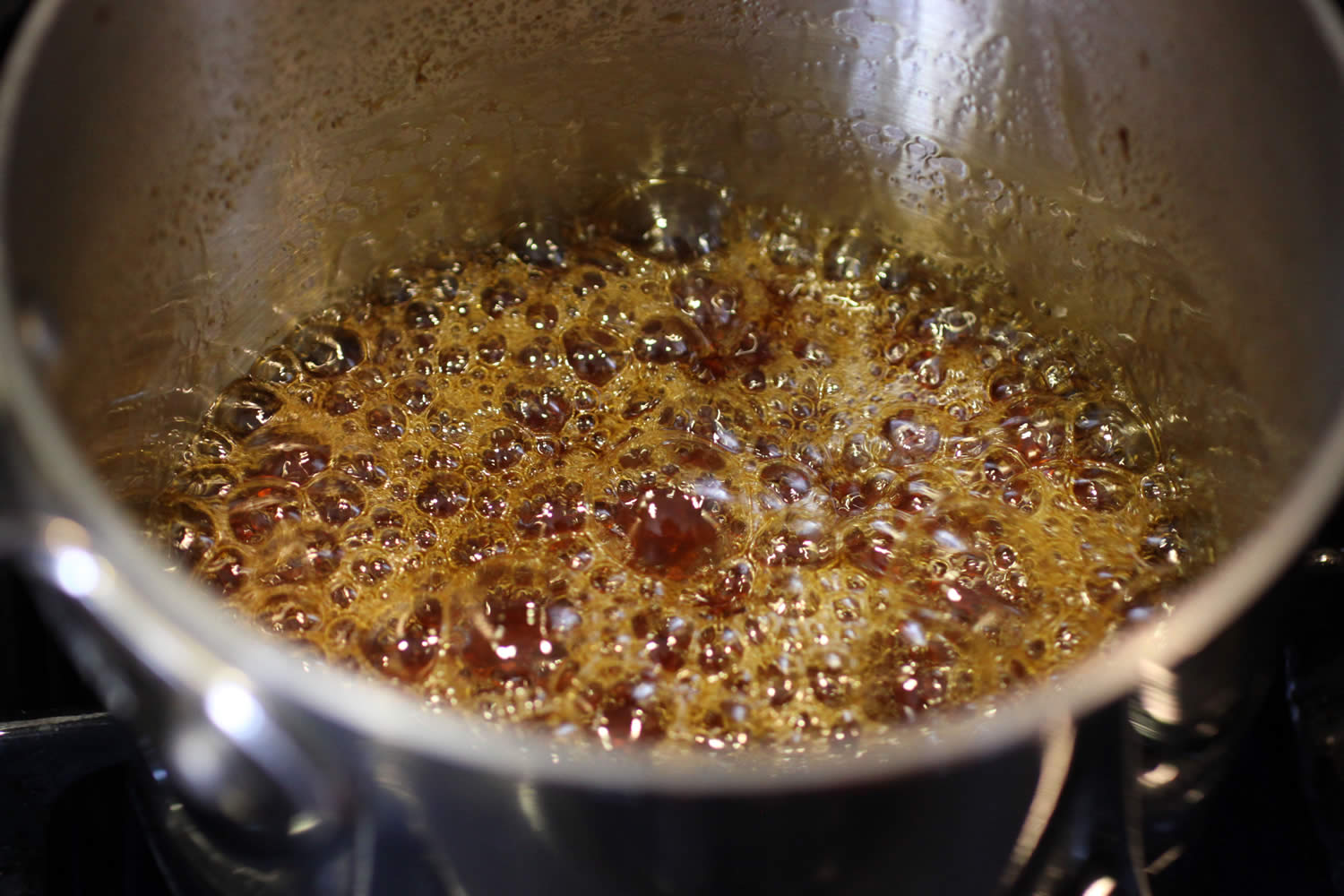
Assembling the Dobos:
- Divide the buttercream into six equal parts.
- Place a dab of chocolate buttercream on the middle of a 7 1/2” cardboard round and top with one cake layer. Spread the layer with one part of the chocolate icing. Repeat with 4 more cake layers. Spread the remaining icing on the sides of the cake.
- Optional: press the finely chopped hazelnuts onto the sides of the cake.
- Propping a hazelnut under each wedge so that it sits at an angle, arrange the wedges on top of the cake in a spoke pattern. If you have any leftover buttercream, you can pipe rosettes under each hazelnut or a large rosette in the centre of the cake. Refrigerate the cake under a cake dome until the icing is set, about 2 hours. Let slices come to room temperature for the best possible flavour.
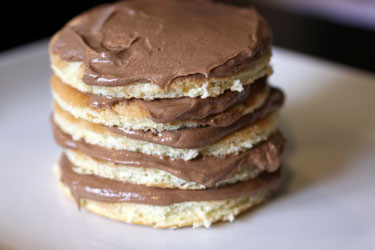
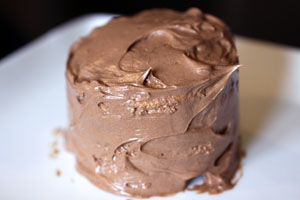
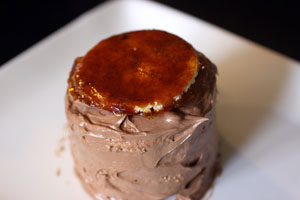

Kudos for the effort you put in though! I hate when you spend some much time on a dish, only to throw it away or give it to the dog!
It looks pretty though! :D
Wow, you are truly a daring baker to tackle this recipe! Lots of moving parts to keep an eye on, and if anything your tortas look great!
Looks lovely. Such chocolate goodness. I love that you made individual cakes. That means I can have one all to myself. LOL. Nice job on the piping, too.
That is gorgeous, and it looks delicious!
alright, your pictures really do make me think they were wonderful; i guess goes to show what a good photographer you are. too bad you didn’t think they worked out well.
Well it surely looks delicious Jen. I know how disappointing it is though to put in so much effort and have something not taste the way you’d hoped.
Oh no! I am so sorry it didn’t work out, but let me say, you did a FABULOUS job at the decorating! Love your piping skills!
I’m sorry the tortas didn’t come out the way you wished, but they look gorgeous! Wonderful job with this challenge – Beautiful photos as well!!
Aww, your little tortas are so cute! Love them!
So much work to end up in the trash—frustrating… valiant effort however!
Awww, they are so cute. No one would have ever known they didn’t tatse as good as they looked…Fantastic job! Too bad it didn’t work out, but hey, now you’ve got one more baking creation ticked off the list.
These are just adorable! Love the step-by-step pictures! :)
oh look at that chocolate! even though they did not work out it looks really great.
Sorry that you didn’t like it but if it’s any consolation, it looks beautiful! :)
Your mini tortas look so cute, I love the beautiful frosting. So sorry that you didn’t like them though after doing all this work :(
The lemon was a little to stronge for me also. I just want thrilled with the taste but your little cakes turned out very cute! :)
Your mini Dobos Torte looks adorable! I love your step-by-step photos! I’m sorry you didn’t love them.
so pretty and cute!! hehe.. wish i get a piece from that yummy Dobos Torte!!
I think it looks fabulous! It’s making me very hungry!
My caramel was way too lemony too! At least yours looked gorgeous!
It looks good though, great of you to post it anyway!
I think most agree that the lemon in the caramel was not needed nor desired! Also, the thing about caramel is, once it hits that beautiful burnished color, it tastes burnt, which stinks, since it makes such a beautiful presentation! Your Tortes are gorgeous..love the piping and how creamy your frosting turned out, the photos really highlighting it! You rocked this challenge… despite not liking how they turned out!
They looks so cute! I’m sorry they didn’t turn out as you hoped.
Jen,
Your Dobos torte looks great! Sorry it didn’t turn out how you wanted. :(
It is so difficult when you put that much work into a recipe for it not to come out but if it is a consolation, the results are beautiful.